ARTICLE AD BOX
Rachel Hagan, Stuart Lau & Helen Sullivan
BBC News
Watch: Major earthquake off Russia triggers widespread tsunami warnings
Tsunami alerts have been scaled back across much of the Pacific after one of the world's strongest earthquakes struck Russia's Far East.
The 8.8 magnitude quake struck near the Kamchatka Peninsula at 11:25 local time on Wednesday (00:25 BST) - triggering tsunami warnings that led to more than two million people being ordered to evacuate in areas including parts of Russia, Japan, and the US state of Hawaii.
Despite the earthquake's strength, there were no reports of severe damage or injury.
"The disaster we were expecting did not come," a Hawaii tourist told the BBC.
Thousands of people along the coast there fled for higher ground as waves of 1.2m hit Oahu, and even larger ones of 1.7m struck Maui.
Governor Josh Green did not hold back when he warned residents: "It is not a regular wave. It will actually kill you if you get hit by a tsunami."
However, a few hours later he reported that: "So far we have not seen a wave of consequence."
The tsunami warning for Hawaii was downgraded to an advisory level by the Pacific Tsunami Warning Centre (PTWC), meaning there is the potential for strong waves, currents and minor flooding, but a major tsunami is no longer expected.
The Hawaii Emergency Management Agency director, Stephen Logan, later said those evacuated could return home but urged people to be careful, drive slowly, and watch for flooding.
Crescent City in northern California, on the west coast of the US, recorded waves of up to 1.09m (3.6ft), according to the National Tsunami Warning Centre.
Further south, there were tidal surges of up to 0.7m in San Francisco. In Los Angeles, the weather service said Port San Luis was seeing a "rapid and damaging surge, going from low to high tide".
British Columbia, in Canada, issued a tsunami advisory for most coastal areas, where residents were told to avoid the ocean and await the all-clear. This was later cancelled.

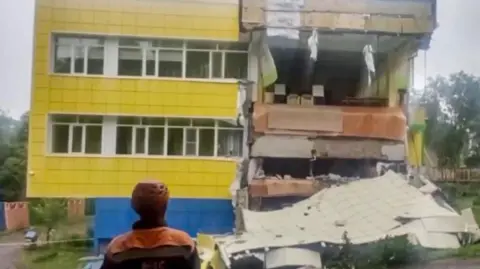 Russian Emergencies Ministry via EPA
Russian Emergencies Ministry via EPA

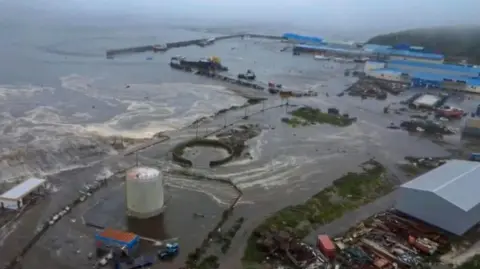 Geophysical Survey Of The Russian Academy Of Sciences via EPA
Geophysical Survey Of The Russian Academy Of Sciences via EPA
In the Russian city of Petropavlovsk-Kamchatsky, several buildings were damaged by the earthquake, including this nursery - but initial reports say no one has been seriously hurt
Pictures from the Russian town of Severo-Kurilsk in the Sakhalin region show flood waters swamping some coastal areas
In Russia, where the quake originated, tsunami waves of up to 5m (16ft) struck areas including Severo-Kurilsk, a port town of about 2,000 people, which was evacuated.
No major injuries or damage were reported and officials later lifted the tsunami warning for Kamchatka, although it was later reported the Klyuchevskoy Volcano had begun erupting.
Russia's Geophysical Survey said red-hot lava had been observed flowing down the western slope of the volcano, which erupts regularly.
The Sakhalin region declared a state of emergency in the northern Kuril islands, where the power grid was shut down after it was damaged by the quake.
Kamchatka Governor Vladimir Solodov described it as the most powerful earthquake the region has experienced in decades. At least six aftershocks followed, including one measuring 6.9.

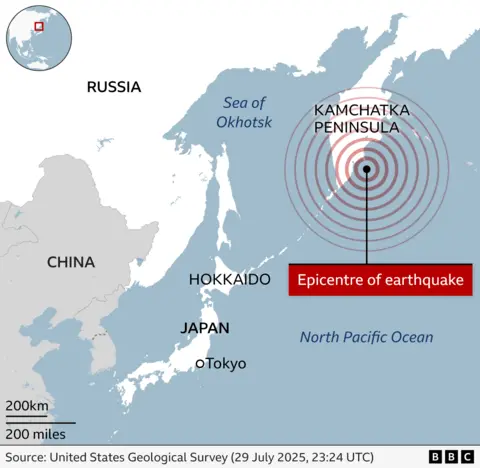
In Japan, thousands were woken by tsunami sirens, with waves more than a metre high hitting the Pacific coast, particularly in Iwate prefecture where nearly two million people were told to evacuate.
Authorities later downgraded the tsunami warning to advisory for many areas, spanning from the north of Tokyo down to Wakayama in the south-west.
Japan's Prime Minister Shigeru Ishiba said there was no confirmation of any damage so far.
At the Fukushima nuclear plant, all 4,000 workers were evacuated, but the plant's operators said there were no "abnormalities" detected.
In March 2011, the plant was hit by a devastating 9.0-magnitude earthquake and tsunami, leading to a nuclear meltdown.

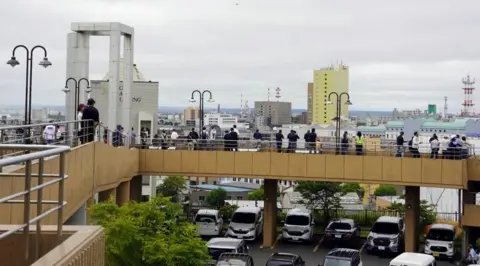 Reuters
Reuters
People take shelter at a temporary tsunami evacuation site in Kushiro, Hokkaido, in northern Japan
In French Polynesia, officials raised predicted wave heights for Nuku Hiva in the Marquesas Islands to 4m, with smaller waves of just under a metre expected on surrounding islands.
The French High Commission there later said wave heights had reached only 1.5m.
Tsunami alerts were also issued for Papua New Guinea, the Solomon Islands and Vanuatu, with coastal residents told to evacuate to higher ground.
China's alert for Zhejiang Province and Shanghai was lifted, with no reported damage, while the Philippines and Taiwan also cancelled their alerts.
Chile, Costa Rica, Ecuador, Australia, Colombia, Mexico, New Zealand and Tonga were all warned of possible smaller tsunami wave activity between 1m-3m.
In Peru, officials issued a tsunami warning and closed 65 of its 125 Pacific ports. Some roads were also closed near a beach in Lima, Peru's capital.
Wednesday's earthquake occurred in a "seismically active" part of the world called the Pacific Ring of Fire. About 80% of the world's earthquakes occur along the ring, according to the British Geological Survey.
Kamchatka lies close to one of these plate boundaries, as does Japan, the Philippines, and the Pacific coast of much of the Americas.
The earthquake was the joint sixth largest-ever recorded along with previous ones off the coasts of Chile and Ecuador. The fifth-largest, a 9.0 earthquake, also occurred near Kamchatka in 1952. It resulted in a 12m-high tsunami to the south of the peninsula.
Are you in any of the affective areas? If it is safe to do so, please get in touch.

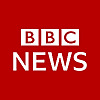 19 hours ago
12
19 hours ago
12
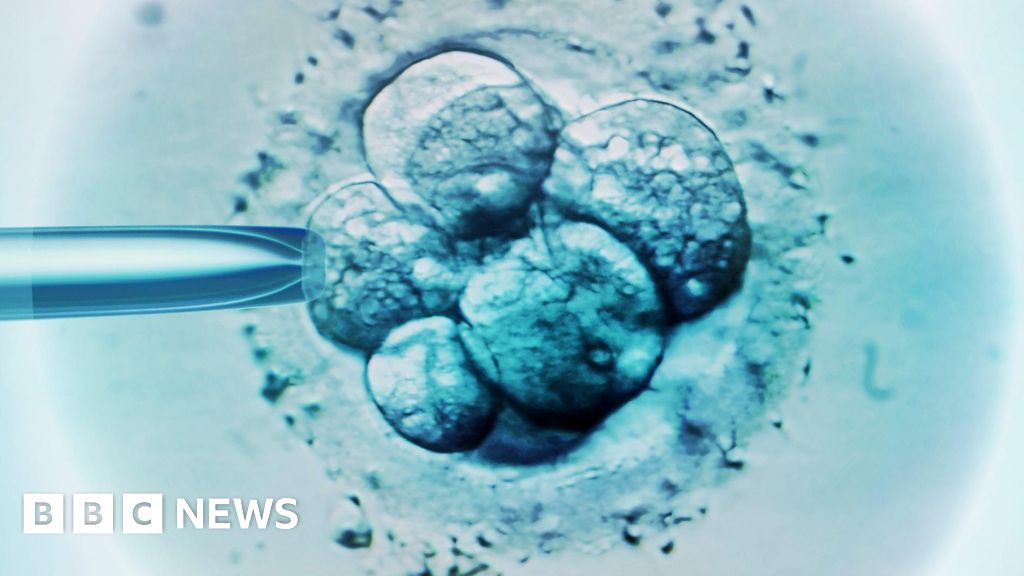
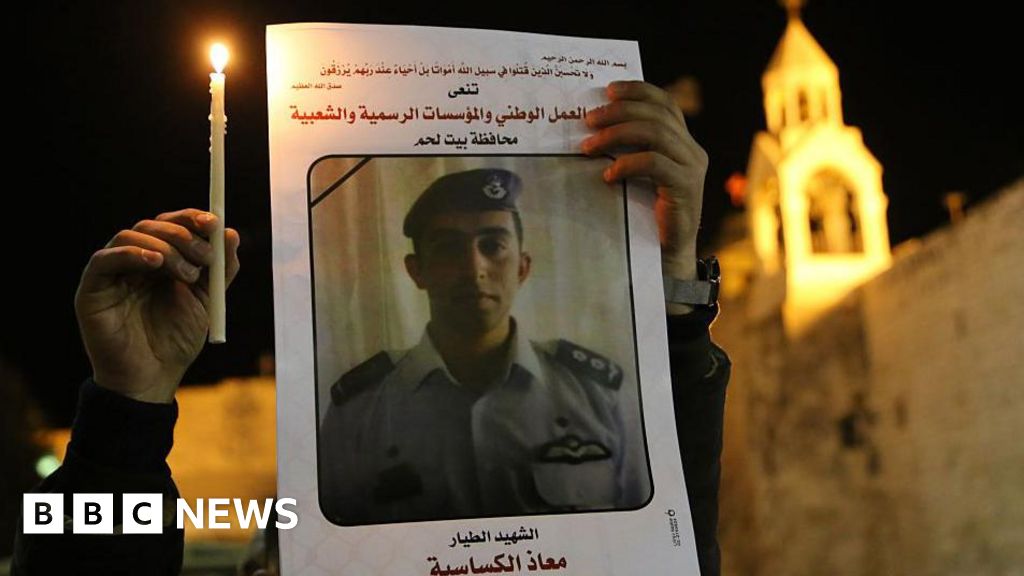






 English (US) ·
English (US) ·